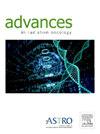为什么体积调制弧线治疗不被认为是乳腺癌局部放射治疗的标准护理?
IF 2.2
Q3 ONCOLOGY
引用次数: 0
摘要
我们量化了需要全面区域淋巴结照射(CRNI)的乳腺癌患者的三维(3D)计划和体积调制电弧治疗(VMAT)之间的剂量学差异。比较50例患者VMAT和3D方案的靶体积剂量、处方等剂量与靶体积的一致性、计划热点、正常组织剂量-体积指标、背部和肩部剂量。用于比较VMAT计划与3D计划的指标包括主要临床靶体积(CTV)接受处方剂量为5000 cGy的98%的百分比、CTV剂量热点、额外治疗体积(ETV)和患者身体接受CTV处方剂量90%的部分(不包括主要靶体积)。与3D方案相比,VMAT方案的这些指标值更高。3D方案中靶体积接受98%处方剂量的平均百分比为95.4%,VMAT方案中为98.9% (P <;. 01)。3D方案的平均目标体积热点为7200 cGy, VMAT方案为5450 cGy (P <;. 01)。3D计划的平均ETV几乎是VMAT计划的两倍(5.3% vs 2.7%, P <;. 01)。VMAT计划导致肩部和背部的剂量降低。当剂量阈值为处方的100%至130%时,VMAT计划的平均总体积较低。VMAT计划通常在机构正常组织剂量限制方面具有优越的价值。对于需要CRNI的乳腺癌患者,VMAT在多个指标上优于3D计划。VMAT的保险范围不应该要求3D比较计划。本文章由计算机程序翻译,如有差异,请以英文原文为准。
Why is Volumetric Modulated Arc Therapy Not Considered the Standard of Care for Locoregional Radiation Therapy for Breast Cancer Patients?
We quantify dosimetric differences between 3-dimensional (3D) planning and volumetric modulated arc therapy (VMAT) in breast cancer patients requiring comprehensive regional nodal irradiation (CRNI). Target volume dose, prescription isodose conformality to target volumes, plan hotspots, normal tissue dose-volume metrics, and back and shoulder dose were compared for VMAT and 3D plans of 50 patients. Metrics used to compare VMAT plans with 3D plans included the percentage of primary clinical target volumes (CTVs) receiving 98% of a prescription dose of 5000 cGy, CTV dose hotspots, the extra treatment volume (ETV), and the portion of the patient's body receiving 90% of the CTV prescription dose (excluding the primary target volume). Superior values for these metrics were found for VMAT plans when compared to 3D plans. The mean percentage of the target volume receiving 98% of the prescription dose of 3D plans was 95.4% versus 98.9% among VMAT plans (P < .01). The mean target volume hotspot of 3D plans was 7200 cGy versus 5450 cGy for VMAT plans (P < .01). A mean ETV found for 3D plans was nearly double that found among VMAT plans (5.3% vs 2.7%, P < .01). VMAT plans resulted in lower doses to the shoulder and back. Mean total body volumes of VMAT plans were lower for dose thresholds of 100% to 130% of the prescription. VMAT plans generally had superior values for institutional normal tissue dose constraints. VMAT is superior to 3D planning across multiple metrics for breast cancer patients requiring CRNI. Insurance coverage for VMAT should not require 3D comparison plans.
求助全文
通过发布文献求助,成功后即可免费获取论文全文。
去求助
来源期刊

Advances in Radiation Oncology
Medicine-Radiology, Nuclear Medicine and Imaging
CiteScore
4.60
自引率
4.30%
发文量
208
审稿时长
98 days
期刊介绍:
The purpose of Advances is to provide information for clinicians who use radiation therapy by publishing: Clinical trial reports and reanalyses. Basic science original reports. Manuscripts examining health services research, comparative and cost effectiveness research, and systematic reviews. Case reports documenting unusual problems and solutions. High quality multi and single institutional series, as well as other novel retrospective hypothesis generating series. Timely critical reviews on important topics in radiation oncology, such as side effects. Articles reporting the natural history of disease and patterns of failure, particularly as they relate to treatment volume delineation. Articles on safety and quality in radiation therapy. Essays on clinical experience. Articles on practice transformation in radiation oncology, in particular: Aspects of health policy that may impact the future practice of radiation oncology. How information technology, such as data analytics and systems innovations, will change radiation oncology practice. Articles on imaging as they relate to radiation therapy treatment.
 求助内容:
求助内容: 应助结果提醒方式:
应助结果提醒方式:


